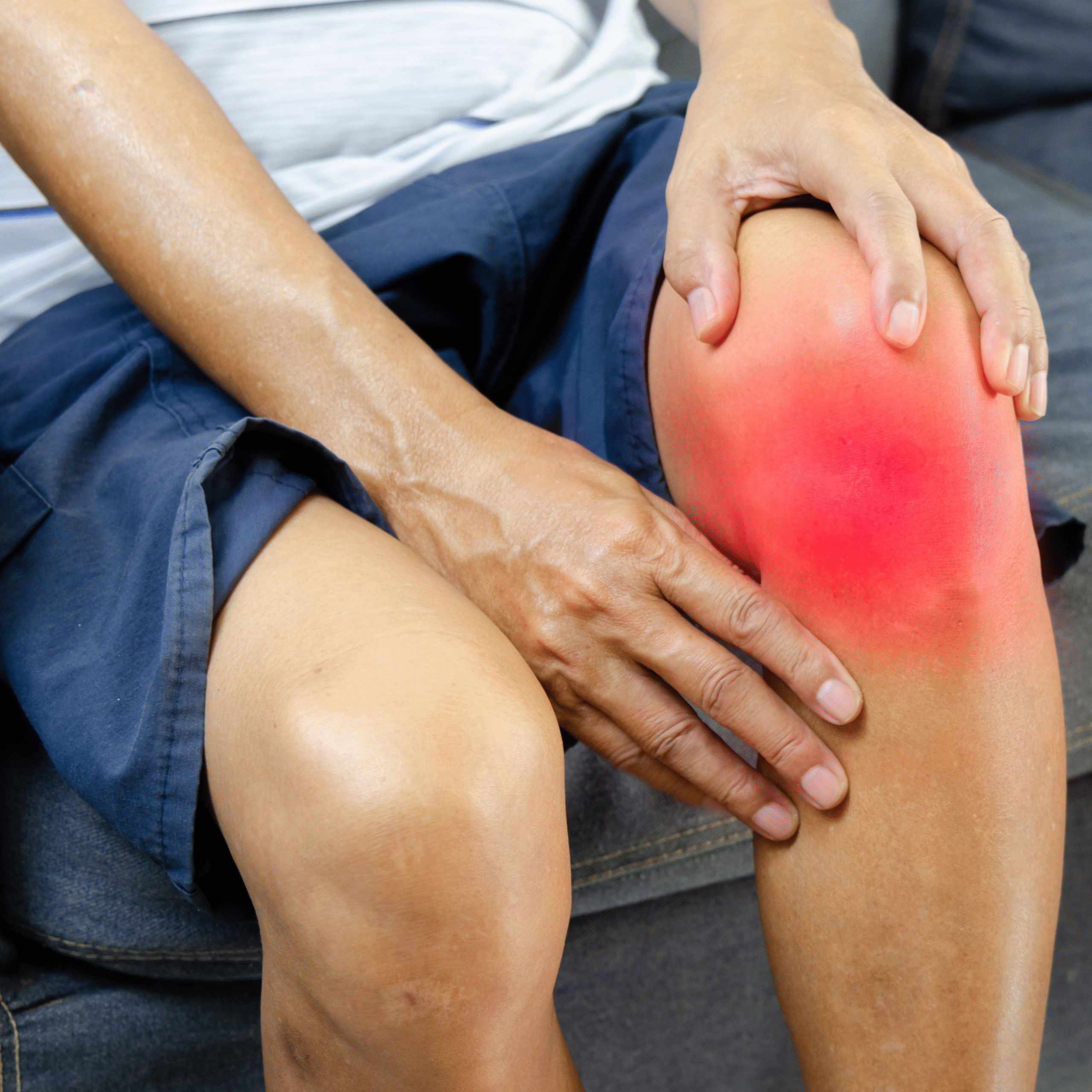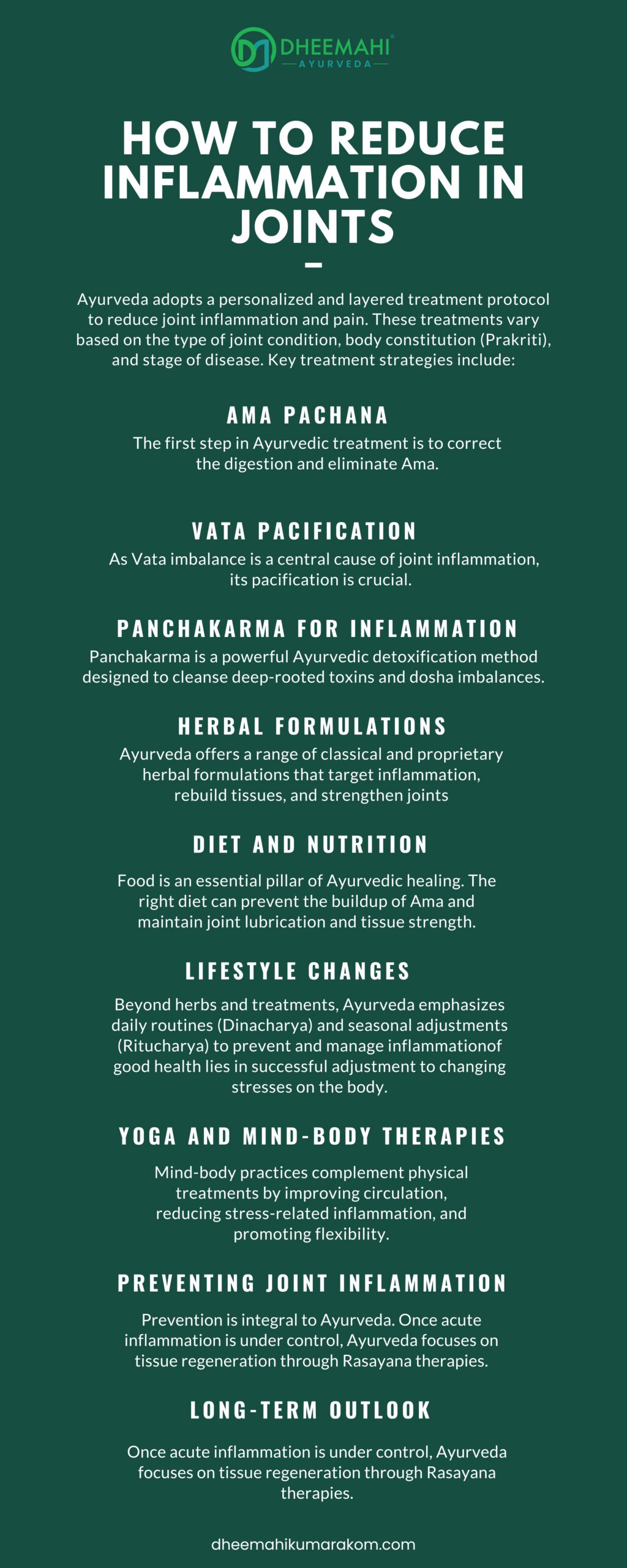How to Reduce Inflammation in Joints with Ayurveda Treatment for Joint Pain
Joint pain has become increasingly common across all age groups, often caused by chronic inflammation that disrupts mobility and quality of life. Whether due to autoimmune conditions like rheumatoid arthritis, age-related wear and tear, or poor lifestyle choices, inflammation in the joints can lead to stiffness, swelling, and discomfort that progressively worsens if left untreated.
While conventional medicine typically addresses joint pain with painkillers, anti-inflammatory drugs, or even surgical interventions, these approaches often come with side effects and rarely tackle the root cause. Ayurveda-the ancient Indian system of medicine-offers a holistic and natural path to reduce joint inflammation by restoring internal balance, detoxifying the body, and strengthening joint tissues.

Understanding Joint Inflammation in Ayurveda
In Ayurveda, joint pain and inflammation are often categorized under conditions like “Sandhivata” (osteoarthritis), “Amavata” (rheumatoid arthritis), or “Vatarakta” (gout). The root causes are linked to:
-
Imbalanced Vata dosha
-
Accumulation of Ama (toxins)
-
Poor digestion (Mandagni)
-
Impaired circulation and nutrition to joint tissues
When Vata is out of balance-the dosha responsible for movement and dryness-it can lead to stiff joints, dry tissues, and cracking noises during motion. When combined with Ama (undigested toxins), it creates inflammatory joint disorders characterized by swelling, redness, and pain.
By understanding how to reduce inflammation in joints as per doshic imbalances and toxin accumulation, Ayurveda focuses on removing the root causes, rather than just suppressing the symptoms. This holistic approach is central to how to reduce inflammation in joints and restore long-term joint health.
If you’re exploring natural and effective methods for how to reduce inflammation in joints, Ayurvedic treatment provides a safe, root-cause-based system for relief and regeneration.
Common Causes of Joint Inflammation
To effectively reduce inflammation in joints, it’s essential to identify the underlying contributors. Ayurveda attributes the causes of chronic joint inflammation to:
- Weak digestive fire (Agni), leading to toxin accumulation (Ama)
- Excessive intake of cold, oily, heavy, or processed foods
- Sedentary lifestyle or excessive physical exertion
- Suppression of natural urges
- Mental stress and emotional imbalance
- Exposure to cold and damp environments
- Hereditary tendencies and autoimmune conditions
Ayurvedic treatments aim to cleanse the body of Ama, restore Agni, and balance Vata dosha to reduce joint inflammation naturally and effectively.

How to Reduce Inflammation in Joints: Ayurvedic Treatment Approach
Ayurveda follows a personalized, multi-step treatment plan to ease joint inflammation and relieve pain. These treatments vary based on the type of joint condition, body constitution (Prakriti), and stage of disease. Key treatment strategies include:
1. Ama Pachana – Digestive Correction and Toxin Elimination
The first step in Ayurvedic treatment is to correct the digestion and eliminate Ama. This is done through:
- Deepana (appetite-stimulating) and Pachana (digestive) herbs like Trikatu, Ginger, and Cumin.
- Light, warm, and easily digestible food that rekindles Agni.
- Herbal decoctions and formulations that promote detoxification through the gut and urinary tract.
By clearing toxins, inflammation is reduced, and joints become more responsive to further therapies.
2. Vata Pacification
As Vata imbalance is a central cause of joint inflammation, its pacification is crucial. Ayurvedic approaches include:
- Warm, nourishing, and lubricating foods with ghee and sesame oil
- Internal and external oleation (Snehana) using medicated oils
- Herbal medicines that calm Vata like Ashwagandha, Rasna, and Bala
- Avoiding cold exposure, fasting, and dry food
These interventions reduce dryness and cracking in joints, supporting tissue repair and lubrication.
3. Panchakarma for Inflammation and Detoxification
- Snehana (Oleation) – Internal and external application of medicated oils
- Swedana (steam therapy): Uses herbal-infused steam to ease stiffness and open up bodily channels.
- Virechana – Therapeutic purgation used to remove excess Pitta and flush toxins from the digestive system.
- Basti – Medicated enemas to pacify Vata and nourish joint tissues
Among all Panchakarma procedures, Basti therapy is especially effective in managing chronic joint pain and inflammation caused by Vata imbalance.
4. Herbal Formulations for Joint Health
Ayurveda offers a range of classical and proprietary herbal formulations that target inflammation, rebuild tissues, and strengthen joints:
- Guggulu-based formulations such as Yogaraj Guggulu, Simhanad Guggulu, and Kaishor Guggulu are commonly prescribed in Ayurvedic protocols.
- Dashamoola for systemic inflammation and pain
- Rasayana herbs like Guduchi and Amalaki for immune modulation and rejuvenation
- Shallaki (Boswellia) and Turmeric for anti-inflammatory action
These herbs work synergistically to reduce inflammation without the side effects associated with long-term NSAID use.
5. Diet and Nutrition to Reduce Joint Inflammation
Food is an essential pillar of Ayurvedic healing. The right diet can prevent the buildup of Ama and maintain joint lubrication and tissue strength. Recommendations include:
- Warm, fresh, home-cooked meals
- Avoiding cold, heavy, fried, or processed foods
- Including spices like turmeric, ginger, cumin, and fenugreek
- Drinking warm water and avoiding iced drinks
- Using ghee for internal lubrication and anti-inflammatory action
Following a Vata-pacifying diet with adequate hydration helps keep inflammation in check and supports long-term joint health.
6. Lifestyle Changes for Joint Health
Beyond herbs and treatments, Ayurveda emphasizes daily routines (Dinacharya) and seasonal adjustments (Ritucharya) to prevent and manage inflammation:
- Gentle exercise like yoga or walking to promote mobility
- Abhyanga (self-massage) with warm oils to lubricate joints
- Ayurveda often uses herbal formulas containing Guggulu, including versions like Yogaraj Guggulu, Simhanad Guggulu, and Kaishor Guggulu, which are frequently included in treatment plans.
- Avoidance of alcohol, smoking, and mental stress
Consistent lifestyle practices help maintain balance in the body and prevent recurrence of inflammation.
7. Yoga and Mind-Body Therapies
Mind-body practices complement physical treatments by improving circulation, reducing stress-related inflammation, and promoting flexibility. Effective yoga postures include:
- Tadasana (Mountain Pose)
- Vrikshasana (Tree Pose)
- Setu Bandhasana (Bridge Pose)
- Balasana (Child’s Pose)
Pranayama (breathwork), meditation, and mindfulness also reduce cortisol levels and systemic inflammation, supporting long-term healing.
8. Preventing Joint Inflammation: Ayurvedic Tips
Prevention is integral to Ayurveda. Simple tips to prevent joint inflammation include:
-
- Eating at regular times to avoid digestive imbalance
- Avoiding incompatible food combinations (Viruddha Ahara)
- Protecting joints from cold and damp environments
- Ayurvedic treatments frequently include herbal compounds made with Guggulu, such as Yogaraj Guggulu, Simhanad Guggulu, and Kaishor Guggulu, which are commonly part of the treatment regimen.
- Seeking early treatment for any signs of digestive or joint discomfort
9. Long-Term Outlook: Ayurvedic Rejuvenation (Rasayana)
Once the acute inflammation is managed, Ayurveda shifts focus to healing and rebuilding tissues using Rasayana therapies, which are designed to rejuvenate and restore overall vitality.
-
- Nourishing herbs like Shatavari, Amalaki, and Guduchi
- Medicated ghee preparations for deeper tissue repair
- Rejuvenation therapies like Ksheerabala Taila, Ashwagandha Rasayana
- Personalized Panchakarma rejuvenation cycles
Rasayana helps restore vitality to joint tissues, builds strength, and reduces the risk of relapse or degeneration.
Conclusion
Ayurveda’s strength lies in its ability to address the root causes of joint inflammation–poor digestion, toxin buildup, and dosha imbalance-through a systematic, personalized approach. Rather than simply masking symptoms, Ayurvedic treatments work to remove the underlying imbalances and restore harmony to the entire system.
If you’re struggling with joint pain and wondering how to reduce inflammation in joints safely and naturally, Ayurveda offers a time-tested, gentle, and holistic path to healing. Through detoxification, herbal medicine, diet, lifestyle, and rejuvenation, Ayurveda not only relieves joint inflammation but also empowers you with tools to prevent future flare-ups and reclaim active, pain-free living.
At Dheemahi Ayurvedic Village, this healing philosophy is brought to life through highly personalized treatment plans designed by experienced Ayurvedic doctors. With a focus on authentic therapies, carefully tailored diets, and a peaceful healing environment
How Our Booking Process Works
The unique approach involves a series of discussion during your initial decision-making process to make sure that we will be able to match your expectations with our treatment.
Based on the discussions with you our team of expert doctors will design the best treatment package personalized for your needs.
01
Consultation Form
Fill out our consultation form, and let us know when will you be available for our doctor to talk to you
02
Discussion with Doctor
Discuss your health condition and expectations with our doctor.
03
Booking Confirmation
Confirm the booking by making a payment of 50% advance.
Consultation Form
Submit this form to initiate a booking with us
Have any queries? We will help you. Talk to us now
Say Goodbye to Health Woes & Hello to Healthy Living
Dheemahi Ayurvedic Pvt Ltd
12/386 Varaputhara Road
Kumarakom, Kerala, India
Pin 686563
Dheemahi Ayurvedic Centre, Near Neelimangalam Bridge, Kumaranaloor, Perumbaikad.P.O, Kottayam, Kerala, India, Pin 686016
Other Treatments
Karkidaka Chikilsa | Ayurvedic Treatment for Depression | How to Reduce Stress Naturally | Autoimmune Disorders | Mental Health Ayurvedic Treatment | Weight-Loss Treatment | Frozen Shoulder Ayurvedic Treatment | Diabetes Ayurvedic Treatment | PCOS Ayurvedic Treatment | Celiac Disease Treatment | ayurvedic treatment for skin diseases | nervous system ayurvedic treatment | Back Pain Ayurvedic Treatment | Cervical Spondylitis Ayurvedic Treatment | ayurvedic treatment for blood sugar | Fatty Liver Ayurvedic Treatment | Knee Pain Ayurvedic Treatment | Migraine Ayurvedic Treatment | Osteoarthritis Ayurvedic Treatment | Psoriasis Ayurvedic Treatment | Sinusitis Ayurvedic Treatment | Ayurvedic Detox Treatment | Migraine Ayurvedic Treatment | Ayurvedic Treatment for Rheumatoid Arthritis | Ayurvedic treatment for joint pain | Ayurvedic treatment for ulcerative colitis | Panchakarma Treatment |
